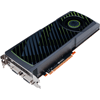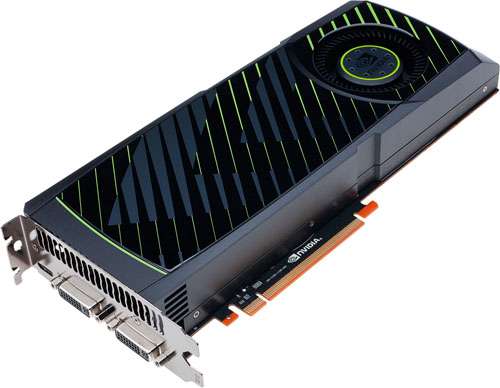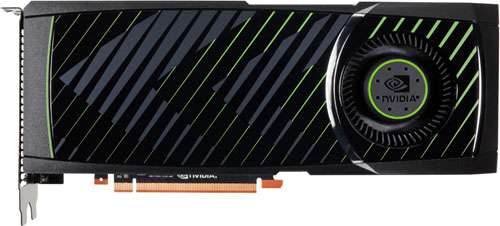- Qualcomm Launches Snapdragon 4 Gen 2 Mobile Platform
- AMD Launches Ryzen PRO 7000 Series Mobile & Desktop Platform
- Intel Launches Sleek Single-Slot Arc Pro A60 Workstation Graphics Card
- NVIDIA Announces Latest Ada Lovelace Additions: GeForce RTX 4060 Ti & RTX 4060
- Maxon Redshift With AMD Radeon GPU Rendering Support Now Available
NVIDIA GeForce GTX 570

To keep the mid to high-end GPU market interesting, NVIDIA has just launched its GeForce GTX 570, a replacement to the GTX 470. It’s priced a bit higher, at $349, but packs extra performance, improved power efficiency and lower temperatures. Is that enough to make it a winner in today’s tight market? We’re here to find that out.
Page 1 – Introduction
When NVIDIA launched its Fermi-based GeForce GTX 400 series this past spring, I don’t think anyone would have imagined that we’d see the 500 series by the end of the year. But, we did, starting with the GeForce GTX 580 last month. What it brought to the table was all of what made the GTX 480 powerful, but also refinements to produce something even faster, more power efficient, and cooler-running. As we discovered in our launch article, NVIDIA did well with this.
After that launch, I had figured it wouldn’t be until early 2011 when we’d begin seeing other GTX 500 models, but I was wrong. It’s clear that NVIDIA is interested in replacing its GTX 400 models as soon as possible with the later parts, due to the number of improvements. As such, the GTX 570 is next on the list, set out to replace the GTX 470, as one might expect.
Similar to the comparison between the GTX 480 and GTX 580, the GTX 570 is meant to be faster than the GTX 470, more power-efficient, cooler, and priced-right. We’ll see throughout this article if NVIDIA hit its mark here as it did for the GTX 580.
Closer Look
As it stands, NVIDIA doesn’t offer a dual-GPU card for either its 400 or 500 series, and as such, the GTX 580 remains its highest-performing card. That card doesn’t have enough oomph to outpace AMD’s dual-GPU Radeon HD 5970, but it does soar past the HD 5870 in most cases. Perhaps with further refinements, and also a die shrink, NVIDIA will once again push out a dual-GPU card.
For those interested, here’s a quick overview of NVIDIA’s current GPU line-up (note that the GTX 470 is for the most part deprecated, but is here for comparison’s sake).
|
Model
|
Core MHz
|
Shader MHz
|
Mem MHz
|
Memory
|
Bus Width
|
Cores
|
| GeForce GTX 580 |
772
|
1544
|
4008
|
1536MB
|
384-bit
|
512
|
| GeForce GTX 570 |
732
|
1464
|
3800
|
1280MB
|
320-bit
|
480
|
| GeForce GTX 470 |
607
|
1215
|
3348
|
1280MB
|
320-bit
|
448
|
| GeForce GTX 465 |
607
|
1215
|
3206
|
1024MB
|
256-bit
|
352
|
| GeForce GTX 460 |
675
675 |
1350
1350 |
3600
3600 |
768MB
1024MB |
192-bit
256-bit |
336
336 |
| GeForce GTS 450 |
783
|
1566
|
3608
|
1024MB
|
128-bit
|
192
|
As one might expect, the GTX 570 isn’t quite a slouch when compared to the GTX 580, but it does have some aspects scaled back in order for NVIDIA to market it to a slightly different crowd, and at a more tempting pricepoint. Though some of the cores have been decreased, the biggest change is with the drop from 512 to 480 cores, a la GTX 480.
NVIDIA is pricing the GTX 570 at $349, which at this point in time doesn’t seem like much of a deal at all, or a way for the company to start taking back some of the market that AMD has claimed over the past year. NVIDIA claims that the new card will be about 20% faster than the one it replaces, the GTX 470, so in that regard the price hike is reasonable. But at the same time, if the card was priced closer to $300, it’d be a lot more tempting, especially when compared to AMD’s HD 6870. We’ll analyze this a bit more in our conclusion.
For the sake of ease, and time, I am once again using NVIDIA’s provided stock images for this review. If at first you think I borrowed the same images as used in our GTX 580 article, you’re wrong, but don’t worry… both cards are nearly identical aesthetically. That even includes the length, as both cards are 10.5″ long.
Like the GTX 580, the GTX 570 features dual DVI ports, and also a mini-HDMI port. This to me pales in comparison to what AMD is currently offering, as you can use a standard HDMI cable right out of the box with one of its offerings. I am hoping NVIDIA can refine the architecture enough here to be able to fit more outputs on the back, for the sake of convenience.
Similar to most higher-end cards on the market, this one requires 2x PCIe 6-pin connectors, and a recommended power supply wattage of 550W. The total TDP for the card is 219W, which is a mere 4W higher than the GTX 470. Given the potential +20% in performance, that 4W could be well worth it.
With the GTX 580, NVIDIA introduced its new “Vapor Chamber” cooler design, and as we saw in our launch article, it proved to be quite effective. That cooling design is brought back to the table with the GTX 570, and along with the further power refinements, the card should be able to handle a bit of pressure while running at modest temperature levels.
On the next page, we’ll talk a bit about our testing methodologies and also give the details on the test machine used, and following that, we’ll get right into testing.
Support our efforts! With ad revenue at an all-time low for written websites, we're relying more than ever on reader support to help us continue putting so much effort into this type of content. You can support us by becoming a Patron, or by using our Amazon shopping affiliate links listed through our articles. Thanks for your support!







